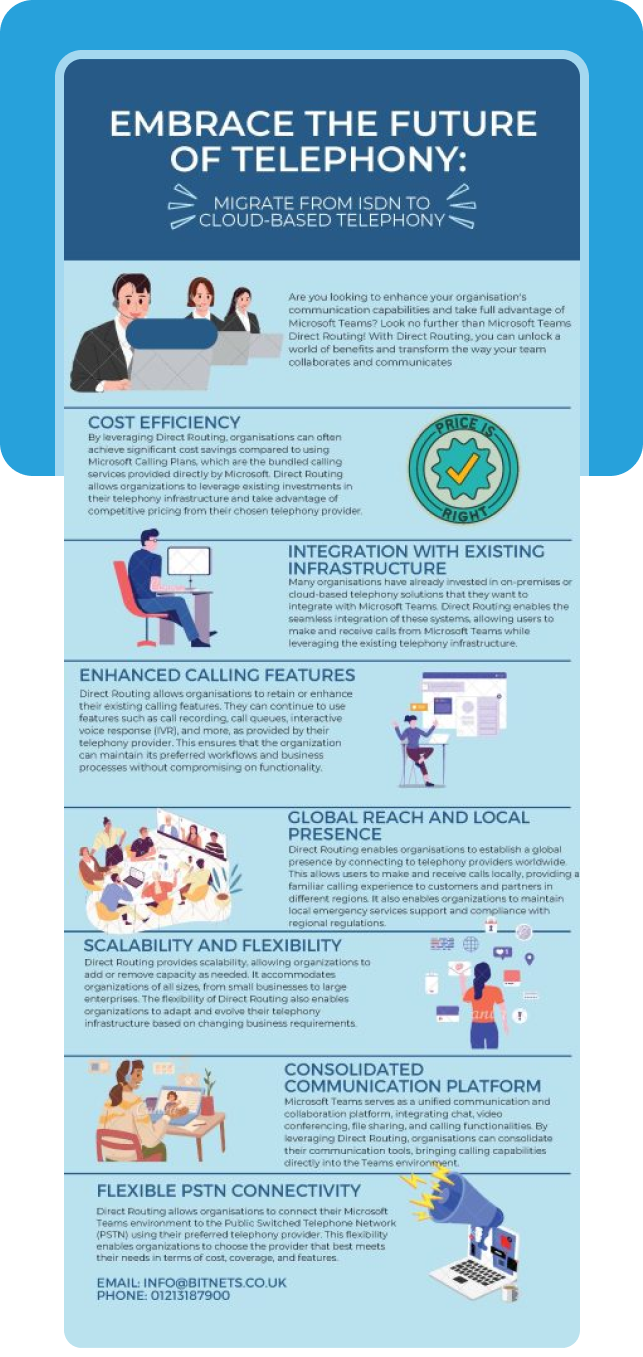
Microsoft UCaaS – Unified Communications as a Service
Cloud Telephony and Communications
As we move closer to 2025, you’re probably starting to come across mentions of the ISDN Switch Off.
Trade publications and the business press may be talking about the impending switch off date, but there’s not a great deal of information as to what these changes mean for businesses, and what you should do in order to prepare.


5 questions about the ISDN Switch Off answered.
The Integrated Services Digital Network – the core of the UK’s current telecoms infrastructure – is soon to be made obsolete.
Businesses need to prepare to move to an internet-based communications protocol before the ISDN is switched off.
Here’s some key information on the switch off, what it means for your business, and what you can do to ensure you are ready for it when it comes round.
1. When will it take place?
- As of December 2020, the first phase of the ISDN Switch off has already begun.
- By September 2023, ISDN services will no longer be available for purchase or renewal.
- In 2025, ISDN will be switched off for good.
2. Where and when will the ISDN services ‘Stop Sell’ come into effect?
- Openreach’s switch plan is to gradually introduce a ‘stop sell’ date for each exchange, after which no ISDN services will be available from that exchange. This includes updates or extensions of existing services.
- The first region to be phased out was Salisbury in December 2020. Contact us to check details of your region.
3. Why is ISDN no longer fit for purpose?
- BT is decreasing investment in its upkeep.
- The quality of service is in decline.
- Fewer ISDN-trained engineers are available to fix faults.
- Availability of parts is dwindling.
4. How many people are still using ISDN?
The drawbacks of maintaining it are outweighing the benefits:
- BT is decreasing investment in its upkeep.
- The quality of service is in decline.
- Fewer ISDN-trained engineers are available to fix faults.
- Availability of parts is dwindling.
Many businesses are yet to adopt an internet protocol:
- 34% of organisations in 2020 were using on-premise phone systems and 50% were still relying on traditional telecoms providers.
- 1 in 4 UK businesses weren’t even aware of the ISDN Switch Off when asked about it.
Meanwhile, the number of businesses using VoIP or cloud telephony is growing:
- 90% of IT leaders will cease purchasing on-premise communication solutions by the end of 2021.
- The number of projected corporate VoIP subscribers is estimated to be around 204.8 billion worldwide.
- 69% of employees use internet-based voice services, including VoIP tools or unified communications platforms.
5. What are the benefits of cloud telephony?
Communications technology has advanced so significantly since ISDN, VoIP is not just a better option for businesses – it’s THE BEST option.
Easy to set up:
- Cloud telephony solutions are ‘plug and play’, meaning they are ready to use straight out of the box.
- Migrating your existing infrastructure to the cloud can be done in a matter of weeks.
Limitless Scalability:
- Cloud telephone systems require no hardware.
- New users can be set up in a few clicks.
- Unlimited new users can be added to your network.
Huge cost savings:
VoIP can save businesses up to 75% on communication costs.
- 90% on international calls
- 75% on operational costs
- 30% on phone bills
Automatic Futureproofing:
Automated updates keep you on the best technology with the latest features at all times.
Powerful flexibility:
Teams can access your network from anywhere on any device. All you need is an internet connection.
With more flexible communications systems, businesses can…
- Embrace hybrid working.
- Remove bottlenecks.
- Enhance the customer experience.
- Improve productivity.
- Retain more talent.
- Have happier teams.